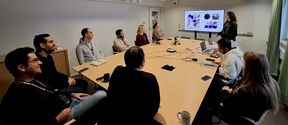University collaboration brings a scope of new possibilities for Planmeca’s business

Collaboration between the Finnish Center for Artificial Intelligence FCAI, dental equipment manufacturer Planmeca and Tampere University Hospital (TAYS) will soon make the work of radiologists, mouth and jaw surgeons and dentists easier, in addition to making the treatment of mouth illnesses even safer.
Together with experts from Planmeca and TAYS, researchers at FCAI have developed a method to help locate the nerve canal of the lower jaw, i.e. mandibular canal. This facilitates the placement of teeth implants, for example. A dentist placing a tooth implant must know the exact location of the mandibular canal in order to plan the size and position of the implant and the entire procedure.
Specialised dentist Jorma Järnstedt from Tampere University Hospital specialises in radiology and dental, oral and maxillofacial diseases. He reveals that for a hospital radiologist, locating the nerve canal is a routine procedure that must be done for each patient.
Normally the task is very time-consuming, and automating it reliably with the help of artificial intelligence makes the work of healthcare professionals faster and easier, in addition to making the treatment safer. 'An algorithm that is medically proven to be reliable makes the patient’s treatment safe while reducing unpleasant, although very rare, surgical injuries,' Järnstedt says.
The benefit of artificial intelligence is that it does the work accurately every time. The new method will be a tool for healthcare professionals, not their replacement. 'The goal of the research work is not to replace radiologists but to create a tool to assist them and make their work faster and more efficient, allowing them to focus on more challenging cases,' says Professor Kimmo Kaski from Aalto University.
Planmeca is one of the world’s leading companies when it comes to manufacturing dental equipment. For Planmeca, the collaboration means new and significant business opportunities. The company plans to include a new feature in its existing software to ensure that the method will be used by healthcare professionals.
Vesa Mattila, Senior Advisor of Medical Imaging at Planmeca Group, has also followed the project with interest. He highlights that the entire collaboration began with the needs of professionals of clinical work. 'At the time, the project had a great chance of succeeding, not just technically and operationally, but also commercially.'
“The industry needs tools such as this one”
Artificial intelligence methods have taken significant leaps in the last years. As for Planmeca, the company has for long been developing technology that is important for the company, 3D X-ray imaging. '3D imaging is the pillar of our business, and we want to utilise it and commercialise the products that have been created using it,' says Vesa Varjonen, Vice President of Research and Technology at Planmeca.
The new deep learning method is based on the training of deep neural networks with a dataset consisting of 3D cone beam CT (CBCT) scans. The research results were published in the prestigious Nature Scientific Reports publication in spring 2020.
Based on the results, the model can effectively identify designated structures in images. The method located mandibular canals on a detailed level and was able to beat statistical shape models, which have previously been determined as the best automated method of locating mandibular canals.
It was important for Planmeca that the collaboration involved FCAI, Aalto University and Tampere University Hospital. Scientific publications are almost indispensable to verify the functionality of the method and gain research status. This and the collaboration with Tampere University Hospital helped to gain patient data for research purposes, which is essential in this type of study.
Vesa Mattila points out that because the field of dental care has moved into 3D imaging, the amount of data has jumped significantly. At the same time, there is a need for more radiologists. 'Thus the industry needs tools such as this one.'
All parties are grateful for their collaboration partners. Although collaboration with instances from different fields is always challenging at first, initial problems were quickly overcome. 'In the initial stage, it felt like we weren’t speaking the same language, but we are now. This is very important for the project,' Mattila says.
Further information
Kimmo Kaski
Professor
Aalto University
kimmo.kaski@aalto.fi
Vesa Varjonen
VP, Research and Technology
Planmeca Group
vesa.varjonen@planmeca.com
Jorma Järnstedt
Specialised dentist
Tampere University Hospital
jorma.jarnstedt@pshp.fi
Link to the research article: https://www.nature.com/articles/s41598-020-62321-3
Read more news

Join Unite's Well-Being Workshop Series
The interactive Zoom sessions are designed to support doctoral students’ well-being, strengthen a sense of belonging, and offer practical tools for success in their academic journey.Create your CV easily with the Research.fi profile tool
Aalto University’s researchers can now create a CV using the CV tool in the Research tool service. The tool generates an editable Word CV based on your Research.fi profile information, following the official TENK CV template.Apply to be a guest professor or visiting researcher at the Université Grenoble Alpes
Unite! partner, Université Grenoble Alpes (UGA) has opened a call to host international professors and researchers for short stays.






